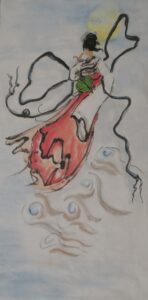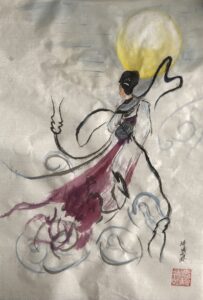CBPS keeps a list of reliable mail-order suppliers.
There is a lot of CBP material available on the internet, but it can be hard to judge the quality, and what is available may change. Here is current information from our Teachers and Group representatives. It also helps if you know what you are looking for, especially with paper: our Getting Started page has a lot of information on CBP materials.
Marion Dearlove uses these mixed hair brushes for her students.
Desmond Chung says “I’ve recently ordered from this shop in Taiwan. Quite good quality and excellent service. There’ll be shipping fees.” This site is in Chinese, but you can make reasonable sense of it with Google translate. Note that overseas suppliers may incur import customs charges.
Judy Bell: “You could try the Heaton Cooper Gallery at Grasmere. I managed to persuade them years ago to stock some Chinese Brush materials. It would be helpful if any members visiting The Lakes could pop in and buy the odd thing so that they will continue to hold some stock”. They have “rice paper” and Wenzhou bark paper rolls.
“Rice paper” seems to be a general term used online for Chinese painting and calligraphy paper, but it is hard to tell exactly what it is for our purposes – eg is it xuan, sized or unsized etc. Bark paper ( 温州皮纸 wenzhou pizhi) often seems to be called rice paper (eg here), though it is made from the the bark of the Paper Mulberry tree (Broussonetia papyrifera). Google translates xuan paper 宣紙 as rice paper.
Anne Allan: “Have you tried temu – I’ve had good success with purchases (though others have not) but I have bought mainly shikishi boards and not xuan.” This does explain if xuan is raw (unsized) or half-cooked (semi-sized).
Peta Allingham: “I purchase packs of raw Xuan paper from T La Art and Craft shop in Manchester (16 Nicholas Street ph. 0161 236 2333 https://orientalworld.co.uk/ ). The sheets are around A2 in size and cost £6 per pack (over 20 sheets but I haven’t actually counted them). I also purchase 250 ml bottles of my favourite Cheong Hwa ink for £5.50 each (the one with the eagle on the box). They can post orders promptly using Royal Mail. Very good service. They do have an online shop where the paper is listed as rice paper but you can phone between 10am and 6pm seven days of the week.” The rolls of paper on this site seems to be Japanese Moon Palace.
Sharon Wybrow: “In answer to your query about paper, I used this one from Amazon for a Calligraphy course I did a couple of years ago with the Chopsticks Club and as recommended by them. I found it a really good and quite kind practice paper especially for the Calligraphy. As it’s white the black ink shows up better than on yellowy grass paper.” The page does state that this is “semi-treated” ie semi-sized.
So I decided to try this one – “Stone Rice calligraphy painting long roll”. As it comes from Hong Kong the delivery charge was quite high. Unfortunately the supplier marked the parcel as GIFT, which meant I had to pay UK VAT plus handling fee – the supplier did refund half as a goodwill gesture. So the paper worked out at about 87pence per metre. The paper has definite smooth and rough sides and does not run, so should be useful for beginners’ practice.”
The Sidewinder paper may be “Grass Paper” P49 from Man Luen Choon.
“Grass” paper (buff practice paper) is made from bamboo.
Pat Jones: making mulberry paper “For information. Good photos too”
Notes on Xuan paper. Xuan can be sized (“cooked”) or unsized (“raw”).


































